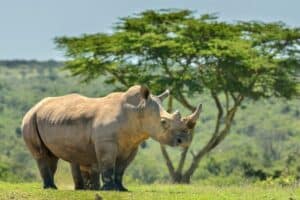The great lumbering odd-toed ungulate could be wiped out in less than 20 years.
Neither poaching, the threat of habitat loss, disease, nor predation of calves, but simply the weather may be responsible for the biggest drop in rhino populations inside the Kruger National Park in recent years.
Combined with a scientific model-based predication, the great lumbering odd-toed ungulate could be wiped out in less than 20 years.
It’s a worrying time for South African National Parks (SANParks) scientists.
“I think the predictions about drought-lag effects will realise in the 2017 census. Those things about birth rates changing for the two different species, the census will confirm those,” said SANParks’ large herbivore scientist Dr Sam Ferreira.
He noted the as yet unverified numbers for 2016 put white rhino in Kruger Park at between 6 649 and 7 830, continuing a downward trend, while black rhino were estimated at between 349 and 465, beginning what may be an upward trend for the beleaguered animal.
It is difficult to conceive now driving through lush greenery and flowing rivers in the park that a few months ago central Kruger was little more than a dust bowl.
In the south, where water still flowed sluggishly in the major rivers, no rain on the plains meant the grass which other browsers such hippos and the teeming herds of buffalo had not yet decimated still had a low nutritional value for close quarter browsers such as black and white rhino.
It hasn’t helped that the majority of rhino have had their traditional routes changed as they are squeezed into the Intensive Protection Zone inside the park, where rangers can throw a ring of steel around them.
Coupled with a rhino’s natural propensity to slow breeding when resources appear low, means a delicate hand has to be applied to the biodiversity management scheme for rhino.
“Density and rainfall-dependent responses in birth and death rates of white rhinos provide opportunities to offset anticipated poaching effects through removals of rhinos from high-density areas to increase birth and survival rates,” Ferreira wrote in a 2015 paper.
“Biological management of rhinos, however, needs complimentary management of the poaching threat as present poaching trends predict detectable declines in white rhino abundances by 2018.”
Which is where the census comes in and while the appearance of the 2016 census has been tardy, Ferreira hoped the 2017 census would be out by early next year, once the paper’s peer review was complete.
In Ferreira’s and Timothy C Haas’ 2016 paper – Conservation Risks: When Will Rhinos be Extinct? – their model used “observed rhino dynamics and poaching statistics”.
The two wrote: “It seeks to predict rhino extinction under the present scenario. This scenario has no legal horn trade, but allows live African rhino trade and legal hunting. Present rhino populations are small and threatened by a rising onslaught of poaching. This present scenario and associated dynamics predicts continued decline in rhino population size with accelerated extinction risks of rhinos by 2036.”
It is hoped the Environmental Affairs Minister Edna Molewa will make it known next year to what extent their paper is considered in their bi-annual presentation on rhino management.
//
For more news your way, follow The Citizen on Facebook and Twitter






